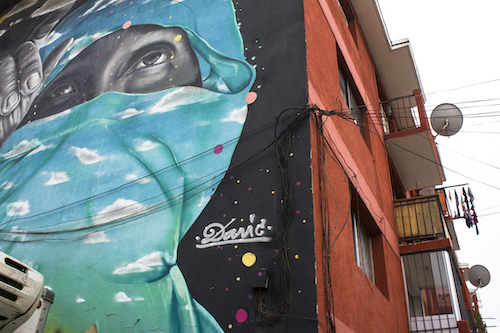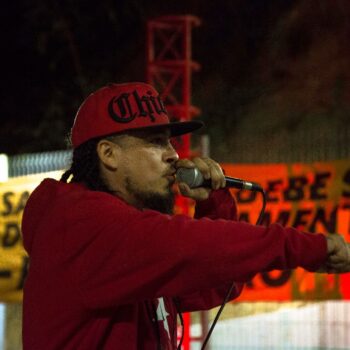While taking a walk in downtown Santiago, I came across Paseo Bandera, a colorful walkway with murals of the capuchas, or the encapuchados — the face-covered front-line protestors. These protestors, most of them teenagers, became heroes during the Chilean social uprising, as they protected the people’s right to protest while taking the brunt of the police repression. I recognized the art as that of my friend Dasic Fernández. We spent a couple of years doing community work together at the Rebel Diaz Arts Collective in the South Bronx and, since then, the Chilean artist has taken his art all over the world. I sat down for a quick conversation with him about his powerful work, which is also featured throughout this issue of The Forge on the Chilean uprising. Our interview has been edited and condensed.
What is the meaning of the capuchas in your art? Is there a direct connection with the protestors in Chile?

The truth is, at the beginning, I started doing Muslim women, drawing their eyes as if they were looking at tourists in the USA and letting them know that the whole world was watching. That’s why they were always facing forward. Later, I realized that this was very close to the protestors that used the capucha. I found a relationship between these struggles, and I was clear that it was all one struggle. One love, one heart. It felt that the capucha was like the armor that people who struggled wore to go out and protest. To me, that person with their face covered is all of us. We all have a struggle. People fight for their families, for their principles, for social justice. I also realized that the struggle wasn’t just connected to one country; rather, the struggle was universal. I think it’s also a struggle to feel free in our own skin. This capucha is almost like a spiritual armor as well.
Your art has many colors in it. Where do you get the inspiration to use all these colors?

My art is mostly in the streets, and in the streets I have to compete with all this visual pollution. We have street signs, advertisements, etcetera, and so I have to go out and struggle against this overload of information and create a piece that gets your attention. I found that the most effective methods were doing realistic portraits of human faces and using lots of colors. Once I have the attention of the viewer, that’s when I can deliver the message. So I started using these methods as a way to relate to the context of my art in the streets and being able to have my pieces survive in the street. With time, I’ve also thought about how rainbows — and it may sound cliche but it’s real — rainbows are what you get after a storm. It’s like after a very tough process, you will get colors that appear, and this is what the colors in my pieces are — they represent hope. The storms eventually end.
You participated in the first Apruebo campaign with an amazing visual. Tell me about the inspiration for that.

The main inspiration was my daughter. She lives in Chile, and I tried to get in her dreams, her way of seeing the world. I wanted to draw the dream of a child, a dream of how we would like to see our country, a country that develops with harmony between humans and nature, that humans see that we are part of nature. It speaks to the vision of the Mapuche, who also tap into their dreams and live in a direct relationship with nature. There’s no before and after, there’s no start and finish, since nature and humans are all one universe. That’s what I wanted to show in that illustration that was transformed into an animation — and it spoke about a world in which we can dream. We gave ourselves the opportunity to dream with this uprising, with this opportunity to write a new constitution, to dream about a better Chile, a new Chile.

